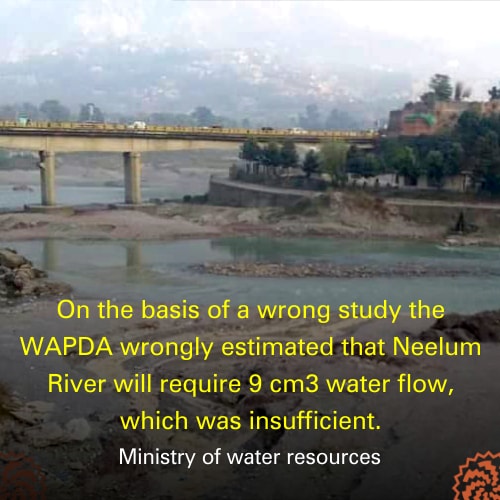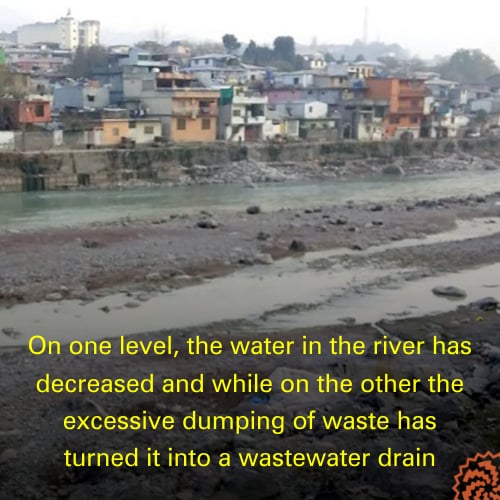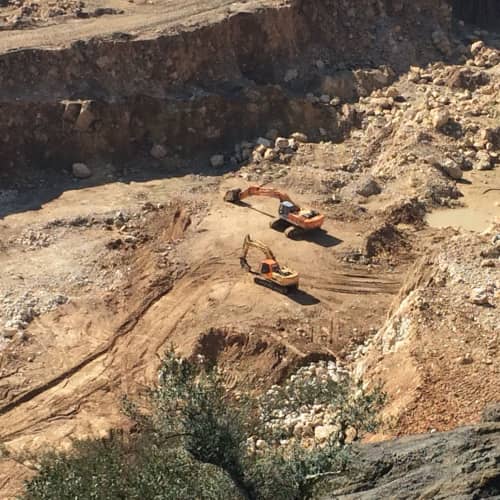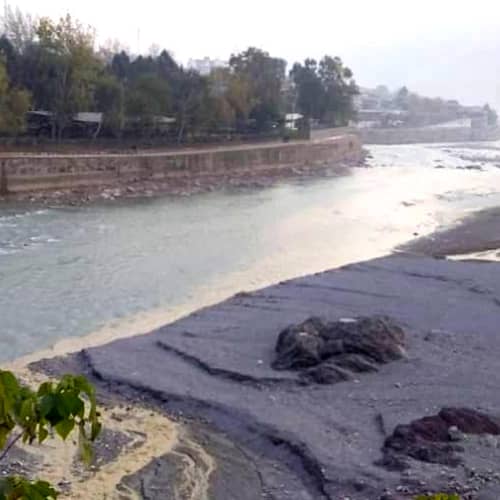In the first week of September 2108, the residents of Muzaffarabad faced an acute shortage of water even when River Neelum passes right through the city.
Locals said water shortage happened due to the Neelum-Jhelum Hydroelectric Project, that diverts River Neelum at Noseri area in the east of Muzaffarabad to drain it into River Jhelum near Chattar Kalas, for generation of 969 of megawatts of electricity.
The environmental impact assessment study for the project conducted in 1997 noted that before it was built, the lowest water flow was recorded in 1982 at 33 cubic meter per second, while the highest flow was recorded at 4000 cubic meters per second during the 1992 floods.
However, when the project started generating power some three years back, the amount of water passing through Muzaffarabad reduced to nine cubic meters per second. It directly affected the city’s water distribution system built in the Marki area and resulted in less water for the locals.
The water shortage prompted protests from the city’s residents. The city administration promised to take up the issue of adequate water supply for the city with the Water and Power Development Authority (Wapda).
However, the issue of water shortage not only affects Muzaffarabad but several villages in the vicinity of the project are also facing the same issue.
Noreen Bibi, 26, a resident of Kiala village said that the natural springs located in the village dried up after 2015-16 and now they have to fetch water from a distance of over three kilometers.
The families in her village have installed water tanks to conserve rainwater for drinking and other needs. However, according to Noreen, water shortage in the village was so severe that neither they could grow vegetables nor keep cattle. “Many families left the village for good [due to the water crisis],” she said.
Parthama, a nearby village, is also facing the same predicament.

Noor Hussain, 45, who runs a grocery store in the village, said that for the past five years, water scarcity has forced him to ride a bike for many kilometers to fetch water. He said in case of a wedding or death in a family, villagers have to order a water tanker from Muzaffarabad.”A tanker costs over Rs 3500 to Rs 4000 and many families cannot afford to purchase it,” he said.
Locals are of the view that the construction of long tunnels over several kilometers, as part of the Neelum-Jhelum Hydroelectric Project dried up the natural springs in the area. A 2018 study conducted by the Azad Jammu and Kashmir Environmental Protection Agency confirms the villagers’ suspicions. The authority in a letter addressed to the project administration noted that tremors caused due to the drilling for tunnels led to the changes in underground waterways, drying up the natural springs in the area.
A series of broken promises
The Norplan Consulting Engineers and Planners, a Norwegian firm, had proposed after detailed studies in 1997 that to ensure environmental balance and meet local needs for water in Noseri and Muzzafarabad, it is important to have at least 20 cubic meters per second water flow in River Neelum. However, Wapda rejected the proposal on the ground that allowing that much water in the river would cause losses worth US$ 65 million, rendering electricity generation from the project too costly for the government.
In 2010, Wapda asked Norplan to revise its estimates and the Norwegian firm reduced its estimates about the city’s population growth. In its initial report, Norplan had projected the city population for the year 2050 at 592, 092 people. Later, after revising the figure down to 337,796, it said it would not be necessary to keep the river flow at 20 cubic meters per second.
However, another study carried out by the Japan International Cooperation Agency showed that Norplan's revised projections were not realistic. The JICA study, dating back to 2007, said that the city's population in 2050 would reach 592,000.
Locals said that the city’s population was on the rise after the devastating earthquake of October 2005 as more and more people from remote areas of the region were shifting to the capital. These migrations were mostly taking place because people wanted to have access to health, communication and transportation facilities in case of major natural disasters.
A 2019 study by the Federal Ministry of Water Resources says that Wapda's 2011-12 environmental impact assessment for the Neelum-Jhelum Hydroelectric Project is far from realistic. On the basis of a wrong analysis, says the Ministry report, the minimum required water flow was kept at nine cubic meters per second which appears to be insufficient.
On the other hand, Azad Jammu and Kashmir Environmental Protection Agency (EPA) while granting permission to the Wapda for the project had made it mandatory for the latter to launch water supply schemes to meet the needs of the city and its outskirts.

EPA director general Adnan Khurshid said that the Wapda was clearly directed on the occasion to start water supply schemes for Muzaffarabad and its outskirts, setting up water treatment plants and constructing water reservoirs for maintaining the city's water table.
In 2014, the EPA had warned to cancel its permission for the Neelum-Jhelum Hydroelectric Project if water supply schemes were not started to meet the requirements of Muzaffarabad, Noseri and Majohi villages.
Turning a river into a drain
Raja Omar Ahsan lives on the banks of River Neelum on Muzaffarabad’s Secretariat Road. In the past, when Ahsan's relatives paid him a visit, they used to sit outside the house by the river to enjoy the cool air of summer evenings. However, he says, these days it is a struggle to even breathe.
Ahsan, a middle-aged man, says it is happening due to the dumping of untreated sewage from the entire city into the river. Besides, waste dumped on the riverside by households, commercial and industrial units also falls into the river.
Dr Ejaz Ahmed, a local doctor, said that the city's waste and sewage was dumped into the river even in the past. "However, its adverse impacts were not visible due to higher water flow. Now on one hand, we have the reduced water flow while on the other hand the amount of garbage and sewage is increasing due to the increase in population."
Dr Ahmed said that due to water pollution, diseases like typhoid, diarrhea and dengue have also increased. The city's temperature has gone up by three to four degrees, he said, due to less water in the rivers, which the federal Ministry of Water Resources substantiated in its 2019 report.
The rain water and sewage drains flowing into the river formed puddles in the dry river bed, providing an ideal breeding ground for mosquitoes.
Also Read

Hurting nature: Cement factory in Chakwal cuts forest and denudes mountains for raw materials
Figures from the World Health Organization substantiate Dr Ahmed’s assertions. According to WHO statistics, Azad Jammu and Kashmir reported 1689 dengue cases in 2019, and a majority of these were in Muzaffarabad. The figure jumped to 2580 in November 2020.
To address these issues, the Azad Jammu and Kashmir Environmental Protection Agency, as a precondition for the approval of the Neelum-Jhelum Hydroelectric Project, had made it binding on Wapda to install 16 plants with the Muzaffarabad Municipal Corporation to treat water before allowing it to flow into the river. However, local officials and the public say no action has been taken to fulfill that condition.
Published on 20 Dec 2021


















